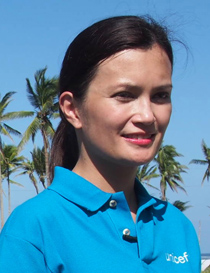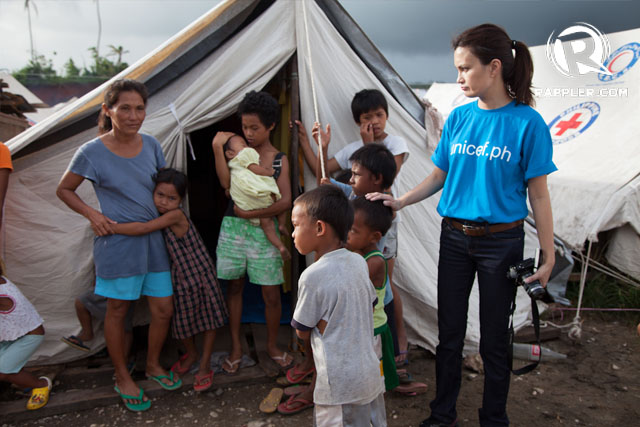SUMMARY
This is AI generated summarization, which may have errors. For context, always refer to the full article.
 I recently went on field mission with United Nations Children’s Fund (UNICEF) to visit children and families affected by Typhoon Pablo in Davao Oriental. I wanted to see how they are coping months after the super typhoon devastated Eastern Mindanao.
I recently went on field mission with United Nations Children’s Fund (UNICEF) to visit children and families affected by Typhoon Pablo in Davao Oriental. I wanted to see how they are coping months after the super typhoon devastated Eastern Mindanao.
Day 1
After travelling for 6 hours by land from Davao City, we visited an evacuation tent city in Barangay Papag in Cateel, Davao Oriental. I walked around with the UNICEF team and the barangay captain gave us a tour of the tent city.
What struck me the most was when somebody in that town looked at me face-to-face and said thank you for coming that far. The families told me that most people don’t visit them because their area was just too far away. The intermittent bad weather did not help either, causing landslides that closed off certain routes to get to Baganga, Cateel and Boston — the 3 most devastated provinces after Typhoon Pablo hit last year.
I met a mother with 12 children. She, her husband, and some of their younger children lived in one of the tents. I looked inside. It was clean but very bare. They hardly had anything left.
The tent city was provided with safe drinking water and temporary toilets by UNICEF and partner NGO Merlin. The children and families were also taught proper hygiene and sanitation skills such as always washing hands with soap and water, and to avoid just relieving themselves out in the open.
Day 2
We visited a nutrition program in Barangay Taytayan, still in Cateel, where UNICEF and Merlin had set up a nutrition and health center with trained doctors and health workers to specifically check for malnutrition in children.
I was able to talk to some mothers with babies and children who had been diagnosed with malnutrition. Now malnutrition, as I’ve learned during my trips with UNICEF is a silent threat. It isn’t just a case of too little food; environmental factors such as clean water and health services are important, as well as the knowledge and behavior of the mother towards child care.
Most of the mothers didn’t even know that their child was suffering from malnutrition until they got diagnosed by the trained health workers. Usually, they come into a health center because the child is sick with pneumonia or something else.
Acute malnutrition
In that town, there’s now some awareness on how to detect signs of malnutrition through the community-based management of acute malnutrition (CMAM).
CMAM is a program developed by UNICEF and health partners that involve community screening of children and an out-patient program administered by municipal health workers and volunteers of the rural health units (RHUs).
Mothers bring their children each week, on a specific day to be weighed and measured and the children are given special peanut based RUTF (Ready-to-Use Therapeutic Food) to eat while in the clinic. As long as the child has appetite and is able to eat the food, the mother is given enough packs for a week, and strict instructions on how to administer it.
Mothers are also counseled on breastfeeding, nutritious food as well as other childcare practices. Any child that cannot eat nor has other complications is admitted to a stabilization center in a hospital.

Brave to recount stories
In the afternoon, we visited Dapnan Elementary School in Baganga, Davao Oriental. The storm blew away almost all of the structures save for one school hall. The main building which was built by the Americans in 1903 was demolished by the storm and all that’s left now is the wooden foundation. The school was right by the shore and I can only imagine how beautiful it was. The principal even showed us pictures of what the school was like with all its beautiful, prize-winning gardens.
During the storm the main building became the evacuation site where people ran to for safety. The storm was so bad causing the structure to collapse. The children who were hiding underneath ran for their lives.
I met some of the children who were brave enough to recount their stories. One girl thought her mother was going to die after suffering from 3 episodes of what could have been a panic attack.
I tried hard to fight back the tears as I listened to their stories.
Hope and rebuilding
What touched me the most was how grateful they were that we visited and that we listened. They were so thankful because they felt that somebody cared enough to go that far to visit them. It was really powerful.
Despite the great loss, there was hope and rebuilding. Teachers were conducting classes in makeshift classrooms and mothers cooked for the children’s meals.
UNICEF also provided school bags complete with school supplies for the children. It was really touching to see that despite everything, they were happy. They were all smiling and joking around. They were connecting with us.

Last day
On our last day, I met a daycare worker in the municipality of Boston. I even joined one of their healing-through-play sessions with her pupils. Teacher Joy taught them an original song called the “raindrop song” which helped the children express their feelings through singing and dancing.
UNICEF through the municipal government provided psycho-social training for teachers and day care workers to better support children in the aftermath of the disaster.
Teacher Joy acts out the song complete with action and lyrics that help children choose positive feelings and good behavior. UNICEF Child Protection Officer Jess Far told me that expression through art, song and dance can help children cope after experiencing tremendous fear and confusion.
Heartbreaking stories
I’ve met so many people and there are too many heartbreaking stories. According to UNICEF, Typhoon Pablo affected an estimated 6.2 million people, 2.6 million of them children. And until now, they still need a lot of assistance in rebuilding, getting their lives back to normal, going back to school, having access to nutritious food and feeling safe. So much still needs to be done.
I am just so glad that UNICEF, partner NGOs, and local government workers are still there on the ground working to help the people affected by Pablo long after the storm has passed.
It’s now a silent emergency because threats of malnutrition, trafficking, and barriers to education are still present. Acres and acres of farm land have been destroyed, and it will take years before crops like bananas and coconut trees will flourish again.
Before leaving for this mission, I was asking myself what I could possibly do for or contribute to the victims of Typhoon Pablo.
Their faces and their stories have stayed with me weeks after the trip. I realized that that is the reason I was sent there — to tell their stories. By going there, writing about what I saw and sharing the stories of the people I have met, I hope that I am able to help them in my own little way. – Rappler.com
TV host Daphne Oseña Paez is a UNICEF special advocate for children. To know more about UNICEF’s emergency response and recovery efforts, visit www.unicef.ph.
To know how you can help Pablo victims, visit http://donate.unicef.ph or call 758-1000. You can also help through Rappler’s continuing “Text to help” campaign.
Add a comment
How does this make you feel?
There are no comments yet. Add your comment to start the conversation.